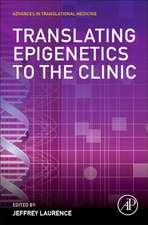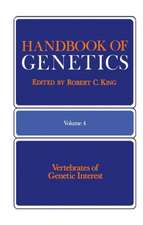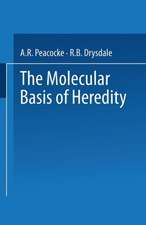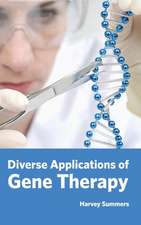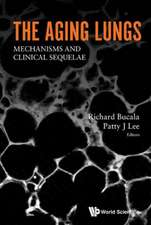Gene Transfer
Editat de R. Kucherlapatien Limba Engleză Paperback – 30 mar 2012
Preț: 376.78 lei
Preț vechi: 396.62 lei
-5% Nou
Puncte Express: 565
Preț estimativ în valută:
72.12€ • 78.36$ • 60.62£
72.12€ • 78.36$ • 60.62£
Carte tipărită la comandă
Livrare economică 21 aprilie-05 mai
Preluare comenzi: 021 569.72.76
Specificații
ISBN-13: 9781468451696
ISBN-10: 1468451693
Pagini: 464
Ilustrații: 462 p.
Dimensiuni: 152 x 229 x 24 mm
Greutate: 0.62 kg
Ediția:Softcover reprint of the original 1st ed. 1986
Editura: Springer Us
Colecția Springer
Locul publicării:New York, NY, United States
ISBN-10: 1468451693
Pagini: 464
Ilustrații: 462 p.
Dimensiuni: 152 x 229 x 24 mm
Greutate: 0.62 kg
Ediția:Softcover reprint of the original 1st ed. 1986
Editura: Springer Us
Colecția Springer
Locul publicării:New York, NY, United States
Public țintă
ResearchCuprins
1 Gene Transfer: A Perspective.- 2 Cell Hybridization and the 24 Human Gene Maps.- 1. Introduction.- 2. Somatic-Cell Hybridization and the Transfer of Whole Genomes.- 3. Somatic-Cell Hybrids for Gene Mapping.- 4. Regional Gene Mapping with Cell Hybrids.- 5. Markers for Mapping the Human Genome.- 6. High-Resolution Chromosome Mapping.- 7. The 24 Gene Maps.- 8. Conclusions.- References.- 3 Microcell Fusion and Mammalian Gene Transfer.- 1. Introduction.- 2. Mammalian Gene Mapping Using Microcell Hybrids.- 3. Monochromosomal Hybrid Panels.- 4. Genetic Analysis of Complex Phenotypes.- 5. Concluding Remarks.- References.- 4 Use of Metaphase-Chromosome Transfer for Mammalian Gene Mapping.- 1. Introduction.- 2. A Short History of Metaphase-Chromosome Transfer.- 3. Introduction of Novel Dominant Markers.- 4. Metaphase-Chromosome Transfer of Introduced Selectable Markers.- 5. Applications and Prospects.- 6. Conclusions.- References.- 5 Vectors for Gene Transfer Derived from Animal DNA Viruses: Transient and Stable Expression of Transferred Genes.- 1. Introduction.- 2. Vectors That Permit Stable or Transient Expression of Transferred Genes.- 3. Vectors That Permit the Maintenance of Transferred Genes as Plasmids.- 4. Comparisons and Conclusions.- References.- 6 Retrovirus Vectors for Gene Transfer: Efficient Integration into and Expression of Exogenous DNA in Vertebrate Cell Genomes.- 1. Introduction.- 2. Retrovirus Life Cycle.- 3. Natural Retrovirus Vectors.- 4. Types of Retrovirus Vectors.- 5. Uses of Retrovirus Vectors.- 6. Problems of Retrovirus Vectors.- 7. Detailed Description of Types of Retrovirus Vectors.- 8. Summary.- References.- 7 Transgenic Mice: Gene Transfer into the Germ Line.- 1. Introduction.- 2. Regulation of Specific Gene Expression in Transgenic Mice.- 3. Physiological Consequences of Altered Gene Expression in Transgenic Mice.- 4. Introduction of Viral Transforming Genes into Embryonic Cells and Transgenic Mice.- 5. Cellular Oncogenes in Transgenic Mice.- References.- 8 Expression of Transfected Genes.- 1. Introduction.- 2. Methodology.- 3. Expression in L Cells.- 4. Inducible Genes in Fibroblasts.- 5. Expression of Globin Genes.- 6. Expression of Immunoglobulin Genes.- 7. Expression of Cell-Surface Antigens.- 8. Summary.- References.- 9 Mutation of Autonomously Replicating Plasmids.- 1. Introduction.- 2. Spontaneous Mutation of Autonomously Replicating Plasmids.- 3. Induced Mutation of Autonomously Replicating Plasmids.- 4. Summary.- References.- 10 Gene Purification by Transfection Methods.- 1. Introduction.- 2. Methods of Isolation.- 3. Developing Approaches.- 4. Conclusions.- References.- 11 Applications of Gene Transfer in the Analysis of Gene Amplification.- 1. Introduction.- 2. Selection of Transformants with Amplified Sequences.- 3. Coamplification of Linked Genes.- 4. Position Effects in Gene Amplification.- 5. The Effect of “Nuclear Environment” on Gene Amplification.- 6. Conclusions and Perspectives.- References.- 12 Retroviral Integration and Insertional Mutagenesis.- 1. Introduction.- 2. Integration Reaction: Sequences and Structures.- 3. Integration Enzymes and Factors.- 4. Insertional Activation and Transformation.- 5. Insertional Mutagenesis.- References.- 13 Homologous Recombination in Mammalian Somatic Cells.- 1. Introduction.- 2. Mitotic Recombination.- 3. Recombination between Exogenously Introduced Homologous Sequences.- 4. Use of Autonomously Replicating Molecules.- 5. Factors That Influence Homologous Recombination.- 6. Recombination between “Cellular” Sequences and Plasmid DNA.- 7.Recombination with a Cellular Sequence.- 8. Cell-Free Systems to Study Recombination.- 9. Summary and Conclusions.- References.- 14 Intrachromosomal Recombination in Mammalian Cells.- 1. Introduction: Method for Studying Recombination between Chromosomal Sequences.- 2. General System.- 3. Deriving Single-Copy Parental Cell Lines.- 4. Analysis of Intrachromosomal Recombination between Direct Repeats.- 5. Position Effects on Gene Conversion.- 6. Factors That Affect Gene Conversion.- 7. Utility of Recombination Studies Employing Inverted Repeats.- 8. Coconversion.- 9. Fidelity of Conversion.- 10. Double Dominant Plasmids to Study Homologous Recombination.- 11. Summary 406 References.- 15 Developments Leading to Human Gene Therapy.- 1. Introduction.- 2. Genetic Diseases as Models for Gene Therapy.- 3. Transplantation in the Treatment of Genetic Diseases.- 4. Gene-Transfer Methods.- 5. Experimental Gene Transfer of Human-Disease-Related Genes.- 6. Ethical Considerations.- 7. Summary.- References.

